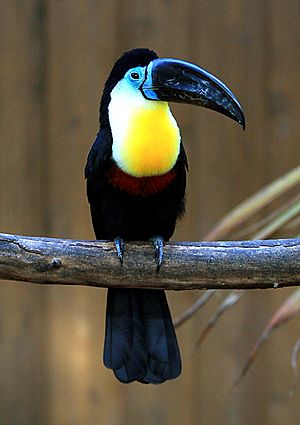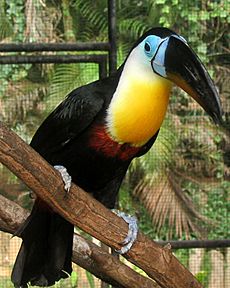Channel-billed toucan facts for kids
Quick facts for kids Channel-billed toucan |
|
|---|---|
 |
|
| R. v. vitellinus at Matsue Vogel Park, Japan |
|
| Conservation status | |
| Scientific classification | |
| Genus: |
Ramphastos
|
| Species: |
vitellinus
|
| Subspecies | |
|
See text |
|
 |
|
The channel-billed toucan (Ramphastos vitellinus) is a colorful bird. It belongs to the toucan family. You can find it on the island of Trinidad. It also lives in tropical South America. Its range goes as far south as southern Brazil and central Bolivia.
Contents
Meet the Channel-billed Toucan
Different Types of Channel-billed Toucans
Scientists recognize three main types, or subspecies, of the channel-billed toucan:
- Yellow-ridged toucan (R. v. culminatus): This one lives in the upper Amazon area. You can find it from western Venezuela to northern Bolivia.
- R. v. vitellinus: This is the original type. It lives in Venezuela, the Guianas, northern Brazil, and Trinidad.
- Ariel toucan (R. v. ariel): This type is found in central and eastern Brazil. It lives south of the Amazon River.
These different types of toucans can have babies together. This happens when their living areas meet. This shows how closely related they are.
What Does It Look Like?
Like other toucans, the channel-billed toucan is very brightly colored. It also has a huge bill. It is usually about 48 cm (19 in) long. Its bill can be 9–14 cm (3.5–5.5 in) long. These birds weigh between 300 and 430 g (10.6–15.2 oz).
- Original type (R. v. vitellinus): Its upper body, belly, and tail are black. The feathers under and over its tail are red. The skin around its eye and the base of its bill are blue. Its throat is white. The middle of its chest is yellow-orange, fading to white. A bright red band crosses its lower chest.
- Culminatus type: This one looks like the original type. But it has a yellow base and ridge on its upper bill. The feathers over its tail are orange-yellow. Its throat and chest are white. A thin red band separates its chest from its black belly.
- Ariel type: This type also looks like the original. But the base of its bill is yellow. The skin around its pale blue eye is red. Its whole throat and chest are orange.
Sometimes, where these different types live close together, you might see toucans that look like a mix of them. This is because they can have babies together.
Where Do They Live?
Channel-billed toucans live in forests and woodlands. They prefer places with lots of moisture. But they can also be found in drier areas, especially near rivers. They mostly live in lowlands. However, they can sometimes be found at higher places, up to 1,700 m (5,600 ft) high.
How Do They Behave?
Channel-billed toucans mostly eat fruit. They especially like fruits rich in fat. These include fruits from Virola and Euterpe palm trees. They also eat fruits from Cecropia, Ficus, and Nectandra trees. If people live nearby, they might also eat papaya, mangoes, avocados, and peppers.
They also eat insects, small reptiles, eggs, and frogs. Their call sounds like a croaking "cree-op cree-op cree-op".
Raising Their Young
Both parent toucans help raise their babies. The mother lays white eggs in a high, empty tree hole. The eggs develop for 18 days. Both parents take turns sitting on the eggs for about 15 to 16 days. Sometimes, they might leave the eggs uncovered for a few hours.
Newborn toucans stay in the nest after hatching. They are born blind and without feathers. Their eyes open after about three weeks. They have short bills. They also have special pads on their heels. These pads protect them from the rough bottom of the nest. Their feathers don't start to grow until they are almost four weeks old.
The young toucans are helpless for about eight weeks. Both parents feed them during this time. After about 40 to 50 days, depending on their size, the young birds start to leave the nest. Then they can begin to take care of themselves.
Gallery
See also
 In Spanish: Tucán de pico acanalado para niños
In Spanish: Tucán de pico acanalado para niños









